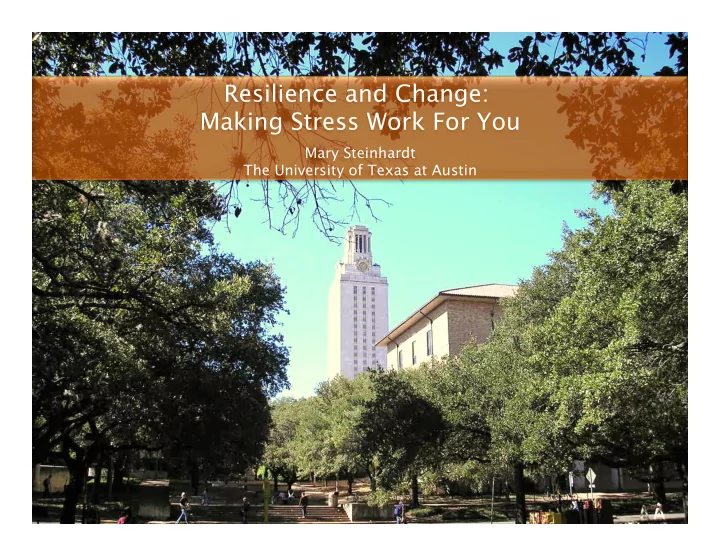

Resilience and Change: Making Stress Work For You Mary Steinhardt The University of Texas at Austin
Thriving (growth) Stressful “STEP UP” Situations FLOURISHING Resilience (recovery) (sustainability) Homeostasis “BOUNCE UP” (protective factors) FOCUSED, FLEXIBLE, FLOWING Disruption (overwhelmed) Diminished (stuck in a rut) “PUT UP” FLOUNDERING Succumb “GIVE UP” FAILURE
Coping Strategies We Use PROBLEM-FOCUSED COPING (engage) Action Planning Positive Reframing Acceptance Using Social Support EMOTION-FOCUSED COPING (disengage) Denial Behavioral Disengagement Self Distraction Self Blame Venting
Thriving (growth) Stressful “STEP UP” Situations FLOURISHING Resilience (recovery) Homeostasis (sustainability) “BOUNCE UP” (protective factors) FOCUSED, FLEXIBLE, FLOWING Disruption (overwhelmed) Diminished (stuck in a rut) “PUT UP” FLOUNDERING Succumb How do the coping “GIVE UP” strategies we use link FAILURE to the four responses?
Thriving (growth) Stressors FLOURISHING “Difficult Situations” Resilience (Strong Foundation) Homeostasis FOCUSED, FLEXIBLE, FLOWING Take Responsibility Disruption Empowering Interpretations “Chaos” Meaningful Connections We’re vulnerable (fragile) We have tremendous potential to grow
The Responsibility Model RESPONSIBILITY Owning your power to choose and create Shame Make Excuses Lay Blame Denial
Circle of Concern Complain Criticize Condemn Compare Circle of Influence Compete Be kind B’s: Be patient Be smart Be a model, not a critic Be a light, not a judge Be part of the solution, not the problem
Control Continuum Act l No Control o r t Influence n o C l a t Adapt o T
Five-Step Process to Help You Move “Above the Line” 1. Watch a replay of the stressful situation, as if you are watching a movie. 2. Identify your position on “the responsibility model.” 3. Ask your heart how you feel about the movie you watched. 4. Create a new movie - an image of what you want to happen. 5. Take responsibility for producing the new movie.
How Will You Take Responsibility? (within your circle of influence and puts you in control) RESPONSIBILITY owning the power of choice and creation Shame Make Excuses Lay Blame Denial
The Resilient Individual… Takes Responsibility Owning the power of choice and creation. Focuses on Empowering Interpretations Placing attention on understanding situations, events relationships, etc. in ways that bring power to as opposed to ways that diminish power. Has Meaningful Connections Seeking and maintaining relationships which create or add a great deal of significance to a person’s life.
How Our Thinking Relates To Our Health Stressor Primary and secondary appraisal processes (Do I have the resources necessary to (Is it important?) handle the situation effectively?) (Is it worth doing something?) Feel Feel Let it go Challenged Threatened Increased Increased health risk of illness
ABCDE Model A dversity or activating event B elief - what you think C onsequences - how you feel & behave D ispute or distract/distance E nergy
Disempowering Interpretations Eight Ways Our Thinking Hurts Us All-or-Nothing Thinking Overgeneralization Negative Mental Filter Jumping to Conclusions Magnify or Minimize Situations Emotional Reasoning Labeling
The Resilient Individual… Takes Responsibility Owning the power of choice and creation. Focuses on Empowering Interpretations Placing attention on understanding situations, events relationships, etc. in ways that bring power to as opposed to ways that diminish power. Has Meaningful Connections Seeking and maintaining relationships which create or add a great deal of significance to a person’s life.
The Rescuing Hug
Meaningful Connections Activity monthly weekly daily YOU People you see daily People you see weekly People you see monthly
Strong Foundation Of Resilience: Things That Once Bothered You Will Not Bother You As Much
Strong Foundation Of Resilience: Some Things May Still Bother You As Much But You Will Recover More Quickly
The Importance of Self-Leadership Physical Energy Spiritual Life Social Purpose Connectedness Self Leadership Emotional Psychological Centeredness Optimism Intellectual Stimulation Adams,T., Bezner, J., Steinhardt, M. (1997). American Journal of Health Promotion , 11: 208-218.
Self-Leadership An active, compassionate inner leader containing the perspective, confidence and vision necessary to lead an individual’s internal and external life harmoniously and sensitively (Schwartz, 1995). Calm Courage Clarity Creativity Curiosity Compassion Connectedness Contentment Confidence As soon as you trust yourself, you will know how to live. Johann Wolfgang von Goethe
The Importance of Positivity THRIVING (growth) flourishing > 4 RESILIENCE (recovery) focused, flexible, flowing >3 (tipping point) Diminished (stuck in a rut) floundering < 3 Succumb Positive emotions fuel resilience (depressive symptoms) and undo or down-regulate the failure negative effects of stress. < 1
Stu Study 1 y 1: T : The Bu e Buildin ilding an g and Bu d Buff fferin ering g Effect Ef cts of s of Posit Positive Emot Emotions ions Note: ¡*p<.05, ¡**p<.01, ¡***p<.001 ¡ ¡ Postdoctoral ¡Experience ¡& ¡Well-‑Being ¡Survey ¡ ¡ ¡ ¡ ¡ ¡ ¡The ¡University ¡of ¡Texas ¡at ¡Aus?n ¡
Resilience The Science of Mastering Life’s Greatest Challenges 1. Optimism: belief in a brighter future 2. Facing Fear: an adaptive response 3. Moral Compass, Ethics, & Altruism: doing what is right 4. Religion & Spirituality: drawing on faith 5. Social Support: seeking & accepting support 6. Role Models: providing the road map 7. Training: physical fitness & strengthening 8. Brain Fitness: challenge your mind and heart 9. Cognitive & Emotional Flexibility 10. Meaning, Purpose, and Growth
Recommend
More recommend